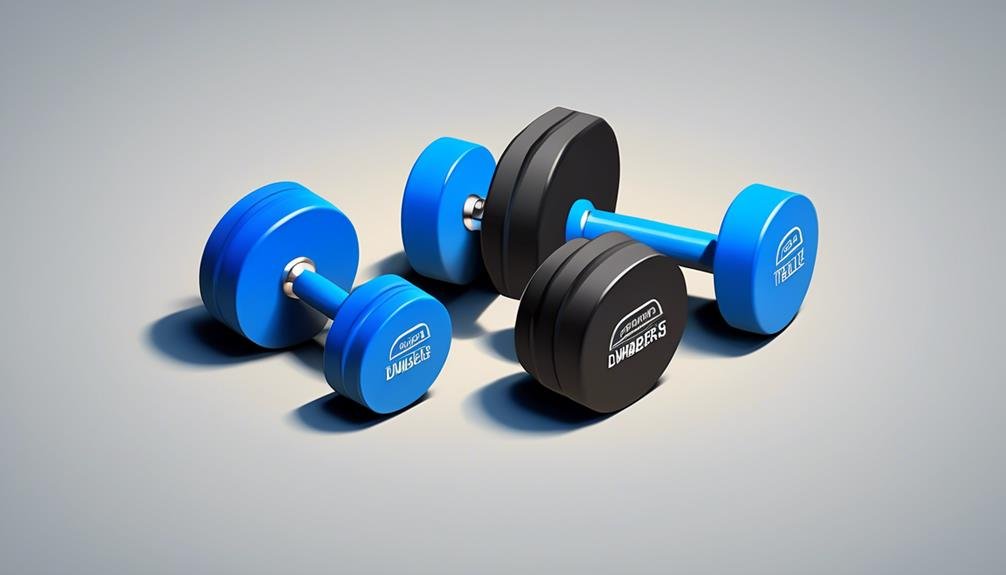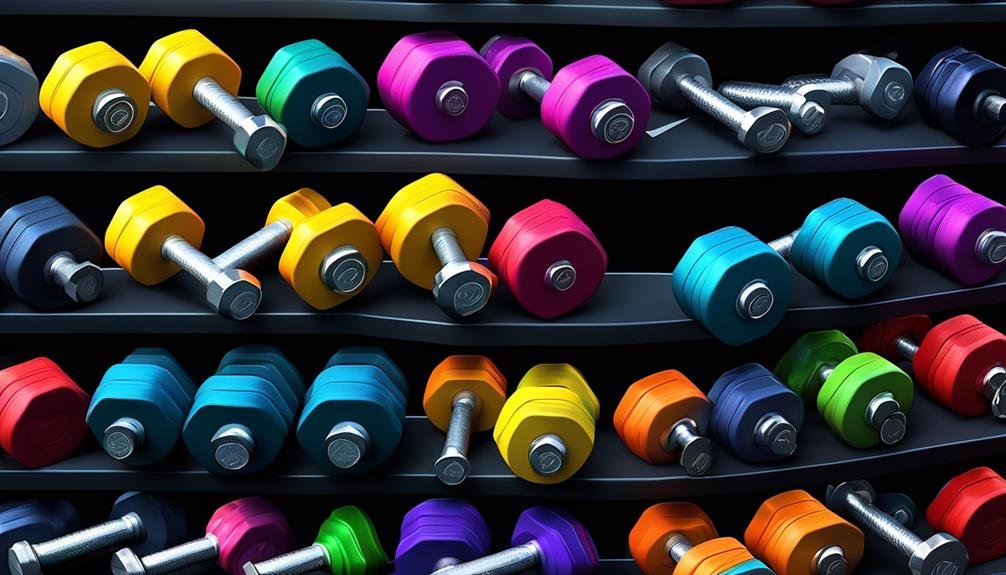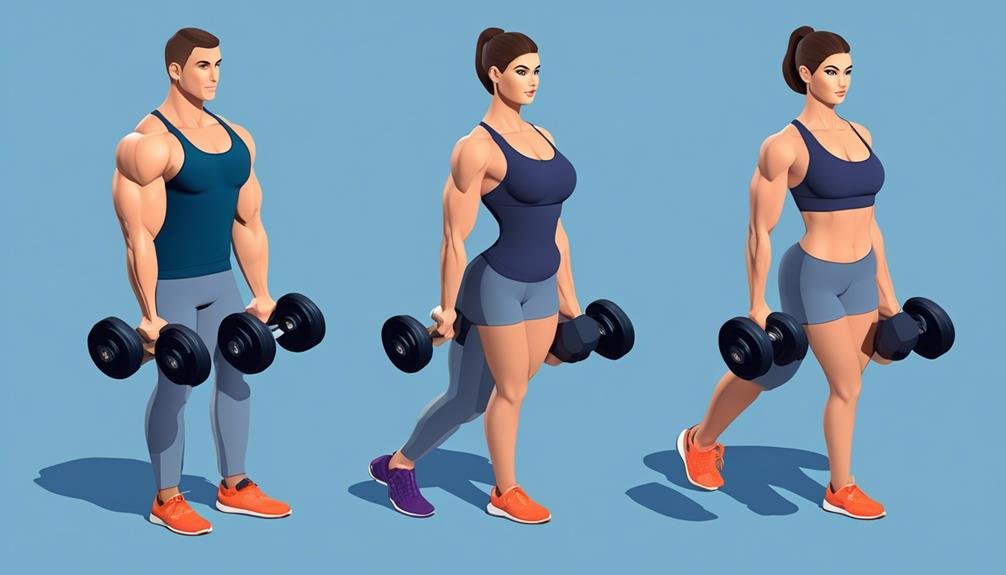When it comes to strength training at home, choosing the right weight dumbbells can be as tricky as trying to find the perfect puzzle piece. With so many options available, how do you know which ones will truly challenge and transform your muscles?
Well, fear not, because in this discussion, we will unravel the mystery behind selecting the ideal weight dumbbells for your home workouts. Whether you're a beginner or a seasoned fitness enthusiast, we've got you covered.
So, grab your water bottle and get ready to discover the key to unlocking your strength potential.
Key Takeaways
- Choosing the right dumbbell weight is important for effective strength training and to reduce the risk of injury.
- Different areas of the body require different dumbbell weights, with heavier weights recommended for leg exercises, medium weights for upper body exercises, and lighter weights for smaller muscles.
- Factors to consider when selecting dumbbell weight include ensuring that the weight challenges muscles without compromising form, considering the type of exercise (compound or isolation), and taking into account different muscle groups and overall strength level.
- Beginners should start with a weight that allows for the desired number of repetitions, using household objects as a guide, and gradually progress to heavier weights as they get stronger.
The Importance of Choosing the Right Dumbbell Weight
Choosing the right dumbbell weight is crucial for effective home strength training. Different areas of your body require different weights to maximize results. When it comes to strength training, using dumbbells is a great way to target specific muscles and build overall strength. However, using the wrong weight can hinder your progress and potentially lead to injury.
To ensure you're using the appropriate dumbbell weight, it's essential to consider the exercises you'll be performing and the muscles you'll be targeting. For exercises that primarily target your legs, such as Bulgarian split-squats and weighted glute bridges, it's recommended to use heavier dumbbells.
On the other hand, exercises like dumbbell bench press and rows, which target your upper body, require medium dumbbell weights. For smaller muscles like those targeted in hammer curls and lateral raises, lighter dumbbells are more appropriate.
Starting with lighter weights and gradually increasing the weight as you build muscle strength is also recommended. By selecting the right dumbbell weight for each exercise, you can effectively target specific muscle groups and achieve optimal results in your home strength training routine.
Factors to Consider When Selecting Dumbbell Weight
To ensure optimal results in your home strength training routine, there are several factors to consider when selecting the appropriate dumbbell weight. The weight of your dumbbells plays a crucial role in the effectiveness of your workouts and can vary depending on different factors such as the specific muscle groups you are targeting and your overall strength level.
When choosing dumbbell weights for your upper body exercises, it is important to select weights that challenge your muscles without compromising proper form. For compound movements like dumbbell bench press and dumbbell shoulder press, medium weights are generally suitable. These exercises engage multiple muscle groups and require a moderate level of strength.
On the other hand, when targeting smaller, weaker muscles or performing isolation exercises like hammer curls and dumbbell lateral raises, lighter weights are typically more appropriate. These exercises focus on specific muscle groups and require more control and precision.
For your lower body exercises, such as Bulgarian split squats and goblet squats, heavier weights are often necessary. Your legs are larger and stronger muscles that can handle more weight, allowing for effective muscle building and strength development.
To help you visualize the appropriate dumbbell weight range for different exercises, refer to the table below:
| Exercise | Light Weights | Medium Weights | Heavy Weights |
|---|---|---|---|
| Dumbbell Bench Press | ✓ | ||
| Dumbbell Shoulder Press | ✓ | ||
| Hammer Curl | ✓ | ||
| Dumbbell Lateral Raise | ✓ | ||
| Bulgarian Split Squat | ✓ | ||
| Goblet Squat | ✓ |
Recommended Dumbbell Weight for Beginners

For beginners, it's important to select an appropriate dumbbell weight to ensure a safe and effective strength training experience. Here are some recommendations to help you get started:
- Consider different weights for different body parts:
- To effectively train each area, use heavier weights for your legs and medium weights for most upper-body exercises.
- This will allow you to challenge yourself without compromising your form.
- Choose the right weight for each exercise:
- Different exercises require different dumbbell weights.
- Use heavy dumbbells for exercises like squats, deadlifts, and bench press.
- Opt for medium dumbbells for exercises like shoulder press and rows.
- Use light dumbbells for exercises like curls and lateral raises.
- Use household objects as a guide:
- If you're unsure about the weight to start with, you can use household objects to gauge the weight for a light set.
- Choose a medium set that's about double the weight of the light set.
- For a heavy set, aim for a weight that's roughly 50% heavier than the medium set.
- Set your fitness goals:
- Your fitness goals should guide your dumbbell selection process.
- For beginners or those recovering from injuries, lighter weights are recommended.
- If you're looking to build stamina, choose moderately challenging weights.
- And if you're aiming to increase muscle mass, opt for heavier weights.
Remember to start with a weight that allows you to perform 1-6 repetitions for strength training, 8-12 repetitions for muscle building, and at least 15 reps for muscle endurance. As you progress in your fitness journey, gradually increase the weight to continue challenging yourself.
Progressing to Heavier Dumbbells as You Get Stronger
Now that you have established the appropriate dumbbell weights for your beginner strength training, it's time to discuss how to progress to heavier dumbbells as you become stronger. When it comes to progressing to heavier dumbbells, there are a few key factors to consider.
First, it's important to choose the right dumbbell weight for each exercise. Different exercises target different muscle groups and require different weights. For example, exercises like Bulgarian split-squats and goblet squats, which work the larger leg muscles, require heavier dumbbells. On the other hand, exercises like hammer curls and lateral raises, which target smaller muscle groups, require lighter weights.
To guide your dumbbell selection, start light and add weight in small increments. As you become comfortable with a certain weight, gradually increase the load to continue challenging your muscles. This progressive overload is essential for building strength and muscle.
Dumbbell Weight Selection for Muscle Building

When selecting dumbbell weights for muscle building, it's important to consider different factors such as the specific muscle groups being targeted and your individual fitness goals and abilities. Here are four key points to keep in mind:
- Consider the muscle group: Different areas of your body require different weights for effective training. For example, exercises like Bulgarian split-squats and goblet squats target the quads and glutes, so heavier dumbbells would be needed for these exercises to see effective results.
- Match the exercise: The type of exercise you plan to do also affects the weight selection. For upper-body exercises like the dumbbell bench press and rows, medium dumbbells are suitable alternatives to cable or barbell exercises.
- Use lighter weights for higher reps: Light dumbbells are often used for exercises like hammer curls and triceps kickbacks. These exercises promote muscle growth with high reps, so using lighter weights allows you to maintain a full range of motion and focus on proper form.
- Consider your fitness goals and abilities: Your individual fitness goals and physical abilities should also guide your weight selection. Beginners or individuals with limited physical abilities may start with lighter weights and gradually progress to heavier ones as they build strength and muscle mass.
Keep in mind that dumbbell weights come in various options such as hex dumbbells, adjustable dumbbells, and neoprene dumbbells. It's important to choose weights that challenge you without compromising your form or risking injury. So, take the time to find the right weights for your muscle building journey.
Dumbbell Weight Selection for Strength Training
To continue your journey in selecting the right dumbbell weights for strength training, it's essential to consider various factors such as the specific muscle groups targeted and your individual fitness goals and abilities.
When it comes to strength training, the weight of the dumbbells plays a crucial role in determining the effectiveness of your workout. For exercises targeting larger muscle groups like the quads and glutes, heavier dumbbells are needed to provide enough resistance and stimulate muscle growth. Exercises like Bulgarian split-squats and goblet squats require a weight of around 122 pounds or more to achieve maximum results.
On the other hand, for upper-body exercises such as dumbbell bench presses and rows, medium-weight dumbbells are more suitable. These exercises focus on building strength in the chest, back, and arms, and using a set of dumbbells that are too heavy may compromise your form and increase the risk of injury. Aim for a weight that allows you to perform 8-12 repetitions with proper technique.
For exercises targeting smaller muscle groups like the biceps and shoulders, lighter dumbbells are sufficient. Hammer curls for the biceps and dumbbell lateral raises for the shoulders can be effectively performed with weights ranging from 5-20 pounds, depending on your strength level.
Ultimately, the right set of dumbbells for strength training will depend on your individual fitness goals and abilities. It's always better to start with lighter weights and gradually progress to heavier ones as your strength improves. Remember, selecting the right dumbbell weight is crucial for building muscle and avoiding injury, so listen to your body and choose accordingly.
Adjusting Dumbbell Weight for Weight Loss and Toning

Adjusting the weight of your dumbbells is crucial for effective weight loss and toning. To optimize your fitness journey, here are four key points to consider when adjusting dumbbell weight for weight loss and toning:
- Different weights for different body parts: Tailor the weight of your dumbbells to the muscle groups you're targeting. For your legs, opt for heavier dumbbells to challenge your quads, hamstrings, glutes, and back. Use medium-weight dumbbells for exercises that focus on your upper body, such as the chest, shoulders, and back. When it comes to smaller muscle groups like the biceps, triceps, and shoulder side-delts, lighter dumbbells are sufficient.
- Exercises with heavy dumbbells: Incorporate heavy dumbbells into your routine for exercises that engage larger muscle groups. Squats, lunges, deadlifts, and rows are examples of exercises that benefit from heavier weights.
- Exercises with medium dumbbells: Medium-weight dumbbells are ideal for exercises that target the chest, shoulders, and back muscles. Think bench press, shoulder press, and bent-over rows.
- Exercises with light dumbbells: Lighter dumbbells are suitable for exercises that isolate smaller muscle groups. Bicep curls, tricep extensions, and lateral raises are great examples.
Frequently Asked Questions
How Heavy Should Dumbbells Be for Strength Training?
Choose dumbbell weights based on the exercises you'll be doing. For heavy exercises like squats and deadlifts, go heavier. For upper body exercises, choose a medium weight. Lighter weights work for smaller muscle groups.
What Weight Dumbbells for Home Workout?
To determine the weight of dumbbells for your home workout, consider your fitness goals and the specific exercises you'll be doing. Start with a variety of weights and gradually increase as you build strength.
How Do I Know What Weight Dumbbells to Use?
To determine the weight of dumbbells you need, consider the exercises you'll be doing. Heavy dumbbells for larger muscle groups, medium for compound exercises, and light for smaller muscles. Start with household objects to gauge.
How Do I Choose Dumbbells for Home Workout?
To choose dumbbells for your home workout, consider your fitness goals, exercise types, and skill level. Use heavier weights for larger muscle groups, medium weights for upper body, and lighter weights for smaller muscles.
Conclusion
In conclusion, selecting the right weight dumbbells for your home strength training routine is crucial for effective results. Consider your fitness goals, exercise type, and skill level when determining the appropriate weight.
Starting with lighter weights and gradually increasing as you progress is recommended.
Whether you're aiming for muscle building, strength training, or weight loss, choosing the right dumbbell weight will help you achieve your desired outcomes.
